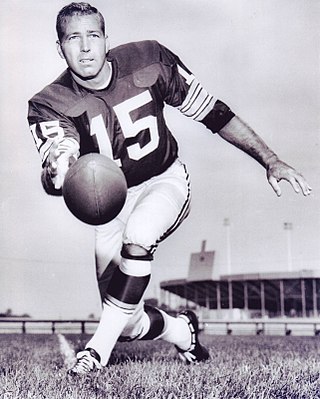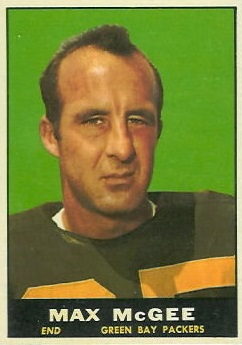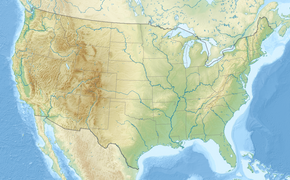
The first AFL–NFL World Championship Game was an American football game played on January 15, 1967, at the Los Angeles Memorial Coliseum in Los Angeles, California. The National Football League (NFL) champion Green Bay Packers defeated the American Football League (AFL) champion Kansas City Chiefs by the score of 35–10.
The second AFL–NFL World Championship Game was an American football game played on January 14, 1968, at the Orange Bowl in Miami, Florida. The National Football League (NFL)'s defending champion Green Bay Packers defeated American Football League (AFL) champion Oakland Raiders by the score of 33–14. This game and the following year's are the only two Super Bowls played in the same stadium in consecutive seasons.

Paul Vernon Hornung, nicknamed "the Golden Boy", was an American football halfback and kicker who played for the Green Bay Packers of the National Football League (NFL) from 1957 to 1966. He played on teams that won four NFL titles and the first Super Bowl. He is the first Heisman Trophy winner to win the NFL Most Valuable Player award, and be inducted into both the Pro Football Hall of Fame and College Football Hall of Fame. Packers coach Vince Lombardi stated that Hornung was "the greatest player I ever coached".

Bryan Bartlett Starr was an American professional football quarterback and head coach for the Green Bay Packers of the National Football League (NFL). He played college football for the Alabama Crimson Tide, and was selected by the Packers in the 17th round of the 1956 NFL draft, for whom he played for 16 seasons until 1971. Starr is the only quarterback in NFL history to lead a team to three consecutive league championships (1965–1967). He led his team to victories in the first two Super Bowls: I and II. As the Packers' head coach, he was less successful, compiling a 52–76–3 (.408) record from 1975 through 1983.
The 1967 NFL Championship Game was the 35th NFL championship, played on December 31 at Lambeau Field in Green Bay, Wisconsin.

James Charles Taylor was an American professional football player who was a fullback in the National Football League (NFL) for ten seasons, with the Green Bay Packers from 1958 to 1966 and with the expansion New Orleans Saints in 1967. With the Packers, Taylor was invited to five straight Pro Bowls and won four NFL championships, as well as a victory in the first Super Bowl. He was recognized as the NFL Most Valuable Player (MVP) after winning the rushing title in 1962, beating out Jim Brown. An aggressive player and fluent trash talker, Taylor developed several personal rivalries throughout his career, most notably with New York Giants linebacker Sam Huff. This confrontational attitude, combined with his tenacious running style, a penchant for contact, and ability to both withstand and deliver blows, earned him a reputation as one of the league's toughest players.
The 1966 NFL Championship Game was the 34th NFL championship, played at the Cotton Bowl in Dallas, Texas. It was the final game of the 1966 NFL season. This was also the last Championship game before the inauguration of the NFL playoffs the following year.
The 1961 NFL season was the 42nd regular season of the National Football League (NFL). The league expanded to 14 teams with the addition of the Minnesota Vikings, after the team's owners declined to be charter members of the new American Football League. The schedule was also expanded from 12 games per team to 14 games per team where it would stay for 16 years. The Vikings were placed in the Western Conference, and the Dallas Cowboys were switched from the Western Conference to the Eastern. The addition of the Vikings returned the NFL to an even number of teams.

Boyd Hamilton Dowler is an American former professional football player who was a wide receiver in the National Football League (NFL). He played 12 seasons from 1959 to 1971, 11 with the Green Bay Packers and one with the Washington Redskins.

William Max McGee was an American professional football player who was an end and punter for the Green Bay Packers of the National Football League (NFL) from 1954 to 1967. He is best known for his seven receptions for 138 yards and two touchdowns, scoring the first touchdown, in the first Super Bowl.

The Green Bay Packers are a professional American football team that has played professionally in the National Football League (NFL) since 1921. The team was founded in 1919 by Curly Lambeau and George Whitney Calhoun, and for the next two years played against local teams in Wisconsin and the upper peninsula of Michigan. In 1921, the Packers joined the American Professional Football Association, the precursor to the NFL, with Curly Lambeau as their coach. After falling into financial trouble, the Green Bay Football Corporation, now known as Green Bay Packers, Inc., was formed in 1923. The Packers became a publicly owned football team run by a board of directors elected each year. The team went on to win six NFL championships from 1929 to 1944, including three straight (1929–1931). Along the way, Curly Lambeau, with the help of receiver Don Hutson, revolutionized football through the development and utilization of the forward pass.
The 1965 NFL Championship Game was the 33rd championship game for the National Football League (NFL), played on January 2, 1966, at Lambeau Field in Green Bay, Wisconsin. This was the first NFL championship game played in January, as well as the first televised in color and the last played prior to the Super Bowl era. It would be staged four more times as a qualifier for the Super Bowl before being replaced with the NFC championship game post-merger.
The 1960 NFL Championship Game was the 28th NFL title game, played between the Green Bay Packers and Philadelphia Eagles on the afternoon of Monday, December 26, at Franklin Field in Philadelphia.
The 1962 NFL Championship Game was the 30th NFL title game, played on December 30 at Yankee Stadium in New York City. It matched the New York Giants (12–2) of the Eastern Conference and Green Bay Packers (13–1) of the Western Conference, the defending league champions.

The 1966 Green Bay Packers season was their 48th season overall and their 46th in the National Football League (NFL). The defending NFL champions had a league-best regular season record of 12–2, led by eighth-year head coach Vince Lombardi and quarterback Bart Starr, in his eleventh NFL season.
The 1967 Green Bay Packers season was their 49th season overall and their 47th season in the National Football League (NFL) and resulted in a 9–4–1 record and a victory in Super Bowl II. The team beat the Dallas Cowboys in the NFL Championship Game, a game commonly known as the "Ice Bowl," which marked the second time the Packers had won an NFL-record third consecutive NFL championship, having also done so in 1931 under team founder Curly Lambeau. In the playoff era, it remains the only time a team has won three consecutive NFL titles.
Lee Roy Caffey was an American professional football player who was an outside linebacker in the National Football League (NFL) for the Philadelphia Eagles, Green Bay Packers, Chicago Bears, Dallas Cowboys and San Diego Chargers. Caffey is one of the top 100 Green Bay Packers of All-Time (#57). Caffey and teammates, Ray Nitchke and Dave Robinson, were named one of the top 10 best linebacking trios in the history of the NFL by ESPN. He played college football for the Texas A&M Aggies and is one of Texas A&M’s top 10 best players in the NFL.
The 1966 Kansas City Chiefs season was the team's seventh season in the American Football League (AFL) and fourth in Kansas City. With an 11–2–1 regular season record, the Chiefs won the Western Division and defeated the Buffalo Bills 31–7 to win their second AFL Championship, their first in Kansas City.
The 1960 Green Bay Packers season was their 42nd season overall and their 40th season in the National Football League. The team finished with an 8–4 record under second-year head coach Vince Lombardi to win the Western Conference and a berth in the NFL championship game. It was the Packers' first appearance in the title game since winning it in 1944. After a Thanksgiving Day loss at Detroit, the Packers won their final three games, all on the road, to win the crown.
The 1961 Green Bay Packers season was their 43rd season overall and their 41st season in the National Football League. The team finished with an 11–3 record under third-year head coach Vince Lombardi, earning them a first-place finish in the Western Conference. The Packers ended the season by shutting out the New York Giants 37–0 in the NFL Championship Game, the first title game ever played in Green Bay. This was the Packers seventh NFL league championship. The 1961 Packers also featured 12 future Hall of Famers, the most on any single team in NFL history.









